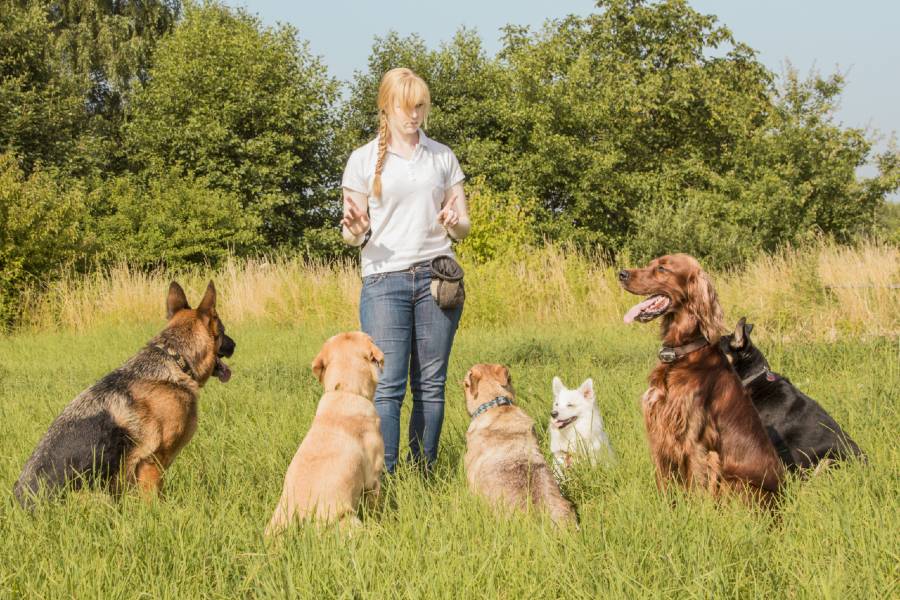Frustrated by your dog not listening? Determined to figure out why? Most dog obedience problems start as miscommunication. Find out why your dog isn’t minding, and what steps you can take to fix the problem.
Regardless of our involvement with dogs – as pet owners, breed fanciers, dog sports competitors, trainers, rescuers – there is one thing we all have in common: there are going to be times when our dogs don’t respond quite how we’d like or expect.
When our dogs don’t listen, it can be embarrassing, frustrating, and disappointing! Most often, these “failures to perform” aren’t caused by stubbornness, willfulness, or dominance; they’re more likely miscommunication.
But what kind of miscommunication?
Before you can take steps to address the problem, you’ve got to identify it. With that in mind, get your thinking cap on, because we’re going to troubleshoot why your dog isn’t listening.
What follows are 8 very common reasons dogs may come across as stubborn and disobedient, when they actually aren’t. It’s not an exhaustive list, but there’s a good chance the reason why your dog isn’t listening is among them!
Browse through and see what description seems to match your dog, and take a look at the recommended solution. After trying it, you may just find out your dog isn’t as stubborn as you thought 😉
Your dog is being inadvertently rewarded for an unwanted behavior
This is one of the most common reasons for what appears to be disobedience. If your dog gets more attention for not obeying than for obeying, his performance of commands will get less and less reliable.
Virtually every dog finds attention valuable and reinforcing.
If your dog behaving badly gets you to suddenly notice him, chase him, push him off you (otherwise known as playing with him), etc., your dog is pretty darned likely to repeat the bad behavior.
The solution:
Always remember, whenever possible, to give attention, praise, and reward while your dog is doing the right thing, and withdraw your attention when he is not.
This takes practice and requires that you notice when your dog is being good! (Not something we all do naturally.)
If it’s impractical to give no attention (say your dog is doing something hurtful or dangerous), then be as boring and unemotional as humanly possible as you stop your dog from doing the thing you don’t like. This way, you’ll take away the “fun” of disobedience and go a long way toward removing the reward for unwanted behavior.
Your words and your body language aren’t agreeing
Our expectations – or lack of them – can make our body language and our words seem in conflict.
While they easily learn to associate words with actions and events, dogs will always be non-verbal animals.
They excel at reading subtle changes in what we call body language and facial expressions, including tone of voice, body tension, and even changes in breathing.
Your dog’s natural tendency will always be to believe your body language. If you are nervous, unsure, awkward, distracted, or preoccupied when giving a command, it’s going to lead to confusion. And confusion is not conducive to perfect obedience!
The solution:
When working with your dog, take a deep breath, put on a smile, and try to visualize giving your command confidently and the dog responding as you would like.
No, it’s not magic, but will greatly increase your chance of success if your dog has been getting mixed signals.
For more depth on this, see my article, How to Communicate Effectively with Your Dog.

Your dog doesn’t know you expect a consistent response
Do you sometimes give commands when you aren’t prepared to follow through if your dog doesn’t respond? Do you ask for a down, but accept a sit because what you really wanted was for your dog to settle? Have you asked your dog to come, but figured it was good enough when he just sort of moved in your general direction (for about 5 seconds, anyway)?
We can only expect a level of consistency from our dogs that we – the teachers – have practiced and expected in training.
The solution:
There is no magic cure for this problem – once you clarify your expectations, and get consistent in what you’ll accept, you’ll see it reflected in your dog’s improved performance.
For some straightforward tips on improving your dog’s consistency, read The 3 Rules of Follow-Through in Dog Training.
Your dog doesn’t realize he can respond in that situation
It’s not unusual for people to increase their expectations too quickly for their dog to understand. Even professional dog trainers do it!
Your dog is perfectly obedient in the kitchen, but a wild man at the park. Your dog can do a 10 minute, rock-solid down-stay in your backyard, but acts like he never heard the word sit when visiting Home Depot. Etc.
The solution:
If your dog is having trouble responding appropriately in a new or especially difficult situation, make minding easier.
Try moving the dog away from whatever’s making it difficult for him. Find a point where you can get a good response.
Then try again in a slightly more difficult situation. Be sure you don’t move on till you get success at that level.
Baby steps will get you to your goal faster than giant leaps, believe me.
Sometimes a dog will get “stuck”, thinking that he simply can’t do what you’re asking. If that happens, it’s best to step back in difficulty until you can get a nice response, then quit for the day.
Pursuing it when your dog is in that frame of mind is unlikely to get you anywhere, and you run the risk of creating a persistent bad attitude in that situation.
As an old trainer of mine used to say “Get Outta There!” – don’t take a chance on teaching your dog that no response is the right response.
Your dog is over-stimulated
Like children, dogs can get “wound up” by too many new sights, sounds, and – in a dog’s case – smells. And like children, this improves with maturity as long as the dog is not allowed to learn that wild behavior is appropriate in stimulating situations.
The solution:
Treat an over-stimulated dog much as you would a child: model calm behavior, quietly reward responses to simple commands, and/or take the dog out of the situation before he is “over the top”.
You can also try engaging him in some calming activity to redirect his attention. (For a dog, this might be lying on his rug chewing a bone or toy, playing a quiet game of tug, snuggling on your lap for a belly rub, or simply taking a nap in his crate.)
If your dog gets over-stimulated easily, be sure s/he’s getting enough time to burn off and be a dog. If you’d like ideas on how to get out and have fun with your pup, while expending some excess puppy energy, check out my article: Enrichment Adventures for Dogs.

Your dog doesn’t have the maturity required for what you’re asking
Certain dog breeds and individuals tend to mature late – as late as 3 or 4 years old. While these dogs are often extremely intelligent and fast learners, they can be quite impulsive or reactive as youngsters.
The solution:
Your best bet with these dogs is to be patient and have a sense of humor, while gradually increasing your expectations as your dog matures. And don’t worry too much, some of our most brilliant and productive minds were late-bloomers!
Your dog hasn’t learned self-control
A young dog can possess quite a bit of self-control, either natural or taught. An emotionally mature dog that has the potential for self-control may never have learned to exercise it!
Self-control is probably the most valuable lesson any dog can learn. This is true for every dog from lapdog to police dog, and all in between.
The solution:
At some point, early or late, every dog needs to learn that he can control his impulses. Obviously the earlier you start teaching this, the better.
For tips on teaching this valuable skill, I highly recommend Suzanne Clothier’s excellent article on teaching self-control.
Your dog is trying to figure out his options
This is the possibility most often labeled stubbornness or even dominance. In reality, virtually everyone tests their job description; it’s normal and understandable behavior.
If your dog thoroughly understands a behavior, and is simply testing to see if, for example, “go sniff the bush” works as an option when asked to sit-stay, you need to clear that question up for him.
The solution:
Be consistent, gently persistent, and insistent. In the sit-stay example above, I’d calmly walk up to the dog, taking his leash or collar, and quietly guide him back to where he should be. I’d remind him with a verbal and/or visual cue (AKA command), and repeat exactly what I’d been doing when he got up and wandered away.
Once he did what he was asked to do, I’d praise well and warmly – but with a hint of authority (i.e. not gushing praise). I’d save gushing for when he did the exercise correctly, without any “reminders”.
It’s perfectly normal and right for a dog to test boundaries.
If your dog does it more than just occasionally, it’s a good idea to make sure your leadership skills are well in place. Read The Role of Leadership in Dog Training for some solid, practical, and (importantly) non-confrontational ways to establish leadership with your dog.
Conclusion
While this certainly isn’t an exhaustive list of possibilities, they are some of the more common I’ve encountered as a professional dog trainer (and yes, while training my own dogs, too).
I hope it got you thinking and maybe even inspired some solid, positive ideas about how to proceed in your training.
I hope you enjoyed and found value in this article. If you did, please share with your friends!
Best,
julie
(bio)



